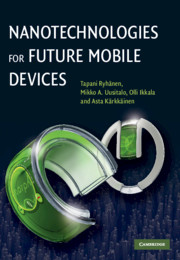Book contents
- Frontmatter
- Contents
- List of contributors
- Preface
- 1 When everything is connected
- 2 On the possible developments for the structural materials relevant for future mobile devices
- 3 Energy and power
- 4 Computing and information storage solutions
- 5 Sensing, actuation, and interaction
- 6 Future of Radio and Communication
- 7 Flat panel displays
- 8 Manufacturing and open innovation
- 9 Seeing beyond the hype: what the Internet teaches us about the development of nanotechnology
- 10 Conclusions
- Index
- References
7 - Flat panel displays
Published online by Cambridge University Press: 05 July 2014
- Frontmatter
- Contents
- List of contributors
- Preface
- 1 When everything is connected
- 2 On the possible developments for the structural materials relevant for future mobile devices
- 3 Energy and power
- 4 Computing and information storage solutions
- 5 Sensing, actuation, and interaction
- 6 Future of Radio and Communication
- 7 Flat panel displays
- 8 Manufacturing and open innovation
- 9 Seeing beyond the hype: what the Internet teaches us about the development of nanotechnology
- 10 Conclusions
- Index
- References
Summary
Introduction
A distinguishing feature of mobile telephones compared with “fixed line” devices since their widespread take-up has been in the inclusion of a display. Given that the functionality of these early devices was largely limited to making and receiving voice calls, the need for a display is not immediately apparent, and indeed many “fixed line” telephones still do not include even the most basic of displays. However, it is the inclusion of a high-quality display that has enabled the mobile telephone to be transformed into a more general mobile communication device. This is because voice communication is an inherently slow means of receiving information (although it is much faster than writing or typing in terms of transmitting information). Human beings absorb information that is written down much more quickly and a wider diversity of information can be presented, such as menu icons, maps, and photographs. In many senses, the nature of the display that can be incorporated into a mobile device limits the functionality that can be attained, and much of the desired functionality of future mobile devices that move us towards a regime of ubiquitous electronics will require significant development of display technology.
This chapter will examine the history of display technology with reference to mobile devices, consider technology developments that are designed to move displays towards greater robustness, improved resolution, higher brightness, enhanced contrast, and mechanical flexibility, and look forward to the “grand problems” that future display manufacturers will need to consider.
Information
- Type
- Chapter
- Information
- Nanotechnologies for Future Mobile Devices , pp. 213 - 228Publisher: Cambridge University PressPrint publication year: 2010
